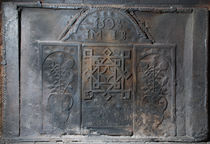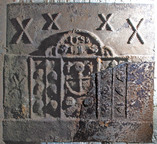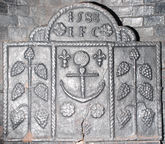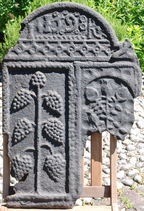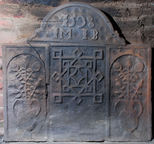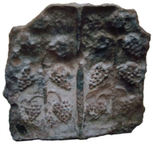-
914
Description: Rectangular shape; twisted rope edging (top and sides) with fillet edging at bottom; cast of a 1598 fireback within a recessed panel, the arch of the original fireback being overlaid with twisted rope and diagonal lengths of rope laid alongside. The original fireback is described as follows: Composite of three elements; central panel has a complex ‘knot’ pattern with a fillet edge; side panel, repeated on either side of the central panel, contains a vase of flowers, possibly stylised thistles, within an arched frame and fillet edge; arched panel above, also with fillet edge, contains the date and inscription; the spandrels of the side panels, and the arched top panel, contain a series of 'bullseye' motifs comprising concentric rings deepening towards the centre.
Notes: The central fireback measures 795mm wide by 735mm high and is from a different casting to that seen at Linchmere, Sussex (no. 475).
Inscription: 1598 / IM IB
- Decoration tags:
- rectangular (shape)
- rope (edging)
- composite
- planklines
- text
- plants
- objects
Manufactured: in the late-16th to early-17th century in the Weald area of England.
Current location: Goddards, Abinger Common, Abinger, Surrey, England.
- Attached to series:
- Armada series
- Composite firebacks
- Garden design types
-
247
Description: A modified recasting of a variant of the ‘Armada’ fireback, with initials changed to IK, a single anchor panel, and the addition of a plain base and borders, the latter each with a twisted rope saltire, upper middle.
Notes: It is likely that an original four-panel fireback has been used to recast a copy with additional side and base panels; the saltires may have apotropaic significance. A second fireback at the house cast in the 19th century is identical but for being 1% smaller all round, and has a full-width extension on top bearing four symmetrical rope saltires, the outer two larger than the inner two. The first example was used to make the second.
Inscription: 1588 / IK
- Decoration tags:
- rectangular with round arch (shape)
- simulated rope (edging)
- simple stamps
- carved pattern panels
- composite
- extension panels
- apotropaic
- text
- plants
- objects
Manufactured: in the 17th century in the Weald area of England.
Current location: Chawton House, Chawton, Hampshire, England.
- Attached to series:
- Armada series
-
1148
Description: A composite recasting placing, on a plain background with symmetrical rope saltires, a recast variant of the ‘Armada’ fireback, with changed initials, a single anchor panel, and the addition of plain base and borders, the latter each with a twisted rope saltire, upper middle.
Notes: It is likely that an original four-panel fireback was used to cast an early copy with additional side and base panels. In the 19th century this second fireback was used to cast this third fireback with an additional full-width extension on top bearing four symmetrical rope saltires, the outer two larger than the inner two. The image of this fireback has been reconstructed by computer, combining photographs of the two fragments into which it had been broken.
Inscription: 1588 / IK
- Decoration tags:
- rectangular (shape)
- none (edging)
- simple stamps
- carved pattern panels
- composite
- apotropaic
- text
- plants
- objects
Manufactured: in the early- to mid-19th century in England.
Current location: Chawton House, Chawton, Hampshire, England.
- Attached to series:
- Armada series
- Composite firebacks
-
281
Description: This fireback comprises at least four separate elements: the rectangular central panel has an anchor with coiled rope between two fleurs de lys, below which are two roses; the two rectangular side panels each comprise a vertical stem with six grape bunches surmounted by a smaller bunch; above, a semicircular arch contains the initials between two roses as in the central panel, with the date above; where the arch meets the central panel there is an arc across each corner; the top and sides panels are edged with simulated twisted rope.
Notes: A variant of the well-known ‘Armada’ fireback. Copies of this fireback were advertised in Bratt Colbran Ltd.'s (London) catalogue in the early-20th century.
Copies of this fireback are known.
Inscription: 1588 / IFC
- Decoration tags:
- rectangular with round arch (shape)
- simulated rope (edging)
- carved pattern panels
- text
- plants
- objects
Manufactured: in 1588 in the Weald area of England.
Current location: Chequers, Ellesborough, Buckinghamshire, England.
- Attached to series:
- Armada series
-
430
Description: Fragment; to the left, rectangular panel with braid edging, vine standard with six bunches of grapes and a cluster at the top; to the right, rectangular panel with wide fillet edging, arched recess with three flower heads in low relief, and in the arch spandrels four 'bullseye' motifs comprising concentric rings deepening towards the centre; on top, a semi-circular panel with fillet edging, within which are the date between the initials, with scattered small rings, below is a pattern of eight linked circles; vestige of another semi-circular panel to the left.
Notes: Potentially a fragment of a large fireback, the vestige of a second semi-circular arched panel on top offers the possibility that several other panels originally existed further to the right. The two surviving panels combine elements from two separate sub-groups of firebacks that were moulded from individual, interchangeable panels, indicating that the sub-groups originated from a common source.
Inscription: I 1598 R
- Decoration tags:
- rectangular with round arch (shape)
- astragal (edging)
- carved pattern panels
- text
- plants
Manufactured: in 1598 in the Weald area of England.
Current location: Anne of Cleves House, Southover High Street, Lewes, East Sussex, England.
Museum number: 1944.24.083 (part of the Sussex Archaeological Society museum group)
- Attached to series:
- Armada series
-
439
Description: Fragment; left part only; this fireback comprises at least four separate elements: the rectangular central panel has an anchor with coiled rope between two fleurs de lys, below which are two roses; the rectangular side panels each comprise a vertical stem with six ‘grape bunches’ surmounted by a circular grape cluster; above, a semicircular arch contains the initials between two roses as in the central panel, with the date above; where the arch meets the central panel there is an arc across each corner. The side and top panels are edged with simulated twisted rope; to the left and botoom, a plain extension has been added before casting.
Notes: One of an unusual series formed from separate panels. The left panel is likely to have been repeated in the missing section. The extensions to the side and bottom will be unique to this casting which, because of the sharpness of the relief detail, is probably an early example. Because of its date and the use of the anchor motif, this much-copied plate is often referred to as the Armada fireback. No other connection with the sea battle is known. Other firebacks have been cast using some of the separate elements described.
Inscription: 1588 / IFC
- Decoration tags:
- rectangular with round arch (shape)
- none (edging)
- carved pattern panels
- heraldic
- text
- plants
- objects
Manufactured: in 1588 in the Weald area of England.
Current location: Anne of Cleves House, Southover High Street, Lewes, East Sussex, England.
Museum number: 1944.24.060 (part of the Sussex Archaeological Society museum group)
- Attached to series:
- Armada series
- Fleur-de-lys firebacks
-
475
Description: Composite of three elements; central panel has a complex ‘knot’ pattern with a fillet edge; side panel, repeated on either side of the central panel, contains a vase of flowers, possibly stylised thistles, within an arched frame and fillet edge; arched panel above, also with fillet edge, contains the date and inscription; the spandrels of the side panels, and the arched top panel, contain a series of 'bullseye' motifs comprising concentric rings deepening towards the centre.
Notes: One of an unusual series formed from separate panels arranged, in this instance, with the outer panel repeated.‘Knot’ patterns were popular in gardens of the period. The garden theme is continued with the side panels. A version of the same design, recorded in a photograph of 1904 at Willesden, London, is a different casting, the top panel with the date and initials, being straight not slightly askew as in this example.
Inscription: 1598 / IM IB
- Decoration tags:
- rectangular with round arch (shape)
- astragal (edging)
- carved pattern panels
- text
- plants
- objects
Manufactured: in 1598 in the Weald area of England.
Current location: in private hands, Linchmere, West Sussex, England.
- Attached to series:
- Armada series
- Garden design types
-
822
Description: Repeated rectangular panels each bearing an anchor with coiled rope between two fleurs de lys, below which are two roses and a grape bunch beneath; the two rectangular side panels each comprise a vertical stem with six grape bunches surmounted by a smaller bunch; above, a semicircular arch contains the initials between two roses as in the central panel, with the date above; where the arch meets the central panel there is an arc across each corner; the top and sides panels are edged with simulated twisted rope.
Notes: One of an unusual series formed from separate panels arranged, in this instance, with each vertical panel repeated.
Copies of this fireback are known.
Inscription: 1588 / IFC
- Decoration tags:
- rectangular with round arch (shape)
- simulated rope (edging)
- carved pattern panels
- heraldic
- text
- plants
- objects
Manufactured: in 1588 in the Weald area of England.
Current location: in private hands, Mayfield, East Sussex, England.
- Attached to series:
- Armada series
- Fleur-de-lys firebacks
-
847
Description: Originally rectangular; two identical panels, each with braid edging, a vine standard with six bunches of grapes and a cluster at the top.
Notes: One of an unusual series formed from separate panels arranged, in this instance, with repeated panel; fire-damaged, hence the distorted shape. Recovered after the fire at Nymans, Handcross, Sussex in 1947.
- Decoration tags:
- rectangular (shape)
- simulated rope (edging)
- carved pattern panels
- plants
Manufactured: in the late-16th century in the Weald area of England.
Current location: not known.
- Attached to series:
- Armada series
-
736
Description: Other examples indicate that this fireback comprises at least four separate elements: the rectangular central panel has an anchor with coiled rope between two fleurs de lys, below which are two roses; this arrangement is repeated alongside; the two rectangular side panels each comprise a vertical stem with six ‘raspberries’ surmounted by a circular berry cluster; above, a semicircular arch contains the initials between two roses as in the central panel, with the date above; where the arch meets the central panel there is an arc across each corner; on the rectangular base panel, on a stippled ground, is a central six-pointed star and a four-strand root system beneath each of the stems in the side panels. The top and sides panels are edged with simulated twisted rope.
Notes: One of an unusual series formed from separate panels arranged, in this instance, with each vertical panel repeated. Because of its date and the use of the anchor motif, this much-copied plate is often referred to as the Armada fireback. No other connection with the sea battle is known. Other firebacks have been cast using some of the separate elements described above. The bottom panel which, unlike the other panels is separately edged with twisted rope, is likely to have been an addition to a copy of an earlier casting (no. 822) and not original.
Copies of this fireback are known.
Inscription: 1588 / IFC
- Decoration tags:
- rectangular with round arch (shape)
- simulated rope (edging)
- carved pattern panels
- text
- plants
- objects
Manufactured: in the late-16th century in the Weald area of England.
Current location: Victoria & Albert Museum, Cromwell Road, Kensington & Chelsea, Greater London, England.
Museum number: M.77-1957 (part of the Victoria & Albert Museum museum group)
Citation: Lloyd, N., 1925, 'Domestic Ironwork I', Architectural Review, 58, pp. 58-67.
- Attached to series:
- Armada series
